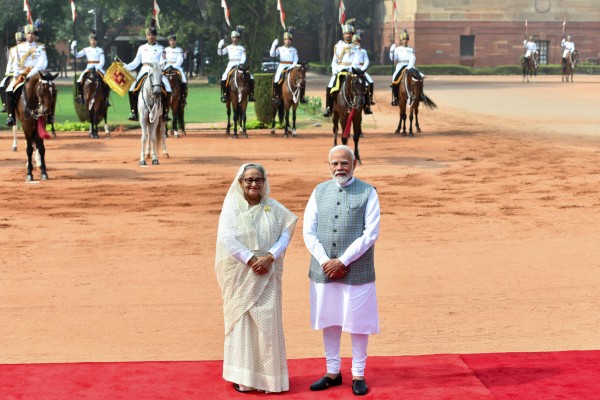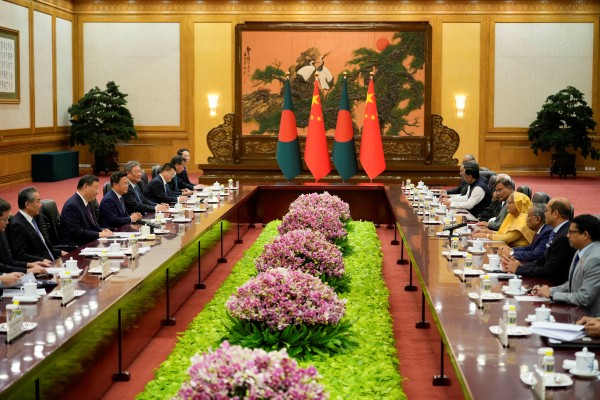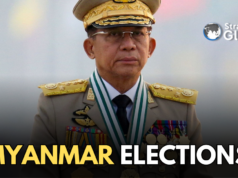Indian media reports that Bangladesh Prime Minister Sheikh Hasina cut her state visit to Beijing July 8- 11 short by a day over Beijing’s failure to deliver promised financial aid and lapses of proper protocol appear to be wishful thinking.
The Prime Minister did, however, return on Wednesday evening instead of Thursday morning as scheduled, reportedly to be with her daughter Saima who was unwell. Indian sources insist that it is very rare for a state visit to be abruptly cut short, and that there was no smoke without fire.
Addressing a press conference on Sunday July 14, Sheikh Hasina said her visit to Beijing, during which she met Chinese President Xi Jinping and Prime Minister Li Qiang, was “a significant part of Bangladesh’s diplomatic activities,” because the bilateral relationship had been upgraded to an ‘Integrated Strategic Cooperative Partnership.”
Bangladesh has been a staunch supporter of China’s core national interests, particularly its ‘One-China’ Policy, while China maintains extremely cordial relations with almost every political party in Bangladesh, both in the ruling alliance and the opposition.
But at the same time, Hasina has taken pains to reassure India — which has serious issues with China post the Galwan clash of June 2020 — that Dhaka’s relations with Beijing would never be at the expense of its ties with India.
The fact that she visited India twice in a span of a month, to attend the swearing-in of the Narendra Modi government’s third term on June 9, and then again on June 21-22 on state visit, is clearly part of that process.
But juggling the demands and pressures from two giant neighbours who don’t get along is difficult tightrope to walk, although Sheikh Hasina has done a commendable job so far.
After Hasina’s state visit to Delhi, the two side released a joint statement titled Shared Vision for Future: Enhancing Connectivity, Commerce and Collaboration for Shared Prosperity, which rests on 14 specific areas of convergence.
Two specific references among those 14 points would certainly have raised red flags among Beijing’s mandarins. One was a reference to a joint “commitment to a free, open, inclusive, secure, and rules-based Indo-Pacific region,” which is a particularly sensitive point with China.
The other was a pledge to “undertake conservation and management of Teesta River inside Bangladesh with Indian assistance within a mutually agreed timeframe.”
This would clearly impact China’s offer to manage and restore the Teesta river, which flows from India, with plans including building embankments along the river near the Indian border and estimated to cost $1 billion, 85% of which will be provided by China as a loan. Teesta water sharing has been a friction point in India-Bangladesh relations, and any Chinese involvement in this would have certainly have New Delhi worried.
But New Delhi has other reasons for concern.
China is Bangladesh’s largest trading partner, with a trade volume of around $25 billion, pushing India to second place. In FY 22, Bangladesh imported goods worth $ 24.25 billion from China and exported goods worth $ 833 million, leading to a trade deficit of $ 23.4 billion. In FY 23, Bangladesh exported $677 million worth goods and imported goods worth more than $22 billion.
The relationship goes way beyond just trade. Over the years, the two sides have signed a plethora of bilateral agreements covering a very wide range of domains including economic and infrastructure development, cultural exchanges, academic interactions and defence cooperation.
Chinese projects and investments (completed and in progress) in Bangladesh is estimated at nearly $ 20 billion. During the decade 2012-13 to 2021-22, China contributed 7% ($ 3.9 billion) of the total bilateral foreign assistance in the form of loans and grants.
Bangladesh, recovering from the Covid pandemic, has recently sought $5 billion soft loan from China for budget support to replenish foreign currency reserves and to pay import bills.
At her press conference Sunday, Sheikh Hasina said during her meeting with Xi on July 10, the Chinese President mentioned four areas of assistance in grants, interest-free loans, concessional loans and commercial loans. “Under these four packages, China has agreed to pay the equivalent of $2 billion to Bangladesh,” she said.
Bangladesh was also the second largest recipient (11%) of Chinese arms exports during 2019-23. China accounted for around 86% of Bangladesh’s arms imports during this period. And in May 2024, the PLA announced joint military exercises with Bangladesh named “China-Bangladesh Golden Friendship”.
As Beijing — with its deep pockets and ability to weaponize trade and grease or bend the elbows of people in power — continues to inexorably tighten its grip on India’s immediate neighbours, New Delhi has started using its soft power and strong cultural ties and transparent economic largesse — to push back.
It has also started developing inter and intra- neighbour relationships, like allowing the use of its grid to let Nepal sell excess hydel power to Bangladesh, and offering its digital stack to help neighbouring governments achieve economic transparency and ease of business, to further strengthen its positioning as an altruistic power, while constantly underlining the dangers of a debt trap posed by Chinese generosity.
Whether or not this will prevail, only time will tell.
In a career spanning three decades and counting, Ramananda (Ram to his friends) has been the foreign editor of The Telegraph, Outlook Magazine and the New Indian Express. He helped set up rediff.com’s editorial operations in San Jose and New York, helmed sify.com, and was the founder editor of India.com.
His work has featured in national and international publications like the Al Jazeera Centre for Studies, Global Times and Ashahi Shimbun. But his one constant over all these years, he says, has been the attempt to understand rising India’s place in the world.
He can rustle up a mean salad, his oil-less pepper chicken is to die for, and all it takes is some beer and rhythm and blues to rock his soul.
Talk to him about foreign and strategic affairs, media, South Asia, China, and of course India.





